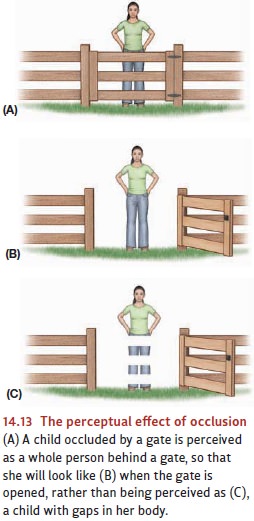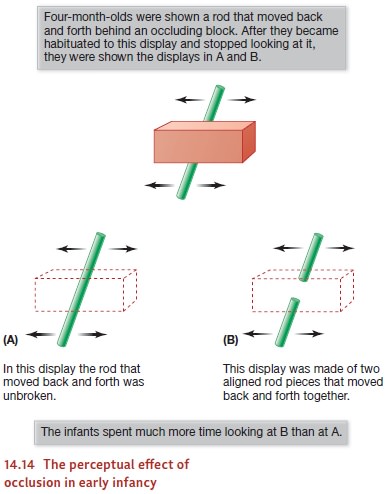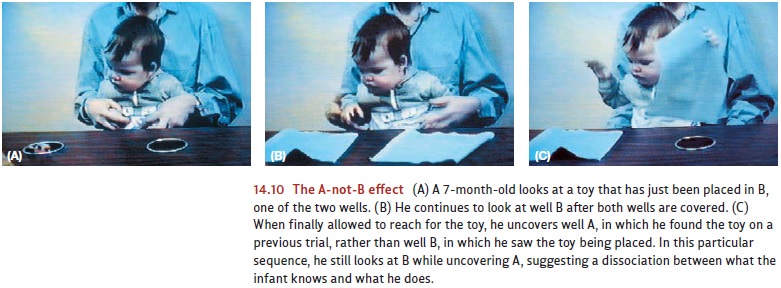Chapter: Psychology: Development
Early Conceptions of the Physical World
EARLY CONCEPTIONS OF THE PHYSICAL WORLD
Consider
Figure 14.13A, which shows an object partially occluding (hiding from view)
another object behind it. Adults viewing this scene will surely perceive it as
a child behind a gate. They are completely certain that when the gate is
opened, they will see a whole child (Figure 14.13B) and would be astounded if
the opened gate revealed a child with gaps in her body (Figure 14.13C).

Do
infants perceive partially occluded objects in the same way? Or are infants’
per-ceptual experiences fragmented, as Piaget proposed? To pursue these
questions, many experiments employ habituation
procedures, in which a stimulus is presented to the infant repeatedly. In
one such study, infants were shown a rod that moved back and forth behind a
solid block that occluded the rod’s central portion (Figure 14.14). This
display was kept in view, and the rod continued to move back and forth until
the infants became bored with it (i.e., habituated) and stopped looking at the
display. The investi-gators then presented the infants with either of two test
displays. One was an unbro-ken rod that moved back and forth (Figure 14.14A).
The other consisted of two aligned rod pieces that moved back and forth in
unison (Figure 14.14B).

If
these infants had perceived the original stimulus as a single complete rod,
then Figure 14.14A would show them nothing new, but Figure 14.14B would seem
novel. If the infants had perceived only the pieces of the original stimulus,
however, Figure 14.14B would show them nothing new and Figure 14.14A would be
the novel display.
Since
these infants had already habituated to the original stimulus, a novel stimulus
should attract their attention and hold it longer. Thus, by measuring how long
the infants looked at each test display, we can find out which of these
displays the infants considered novel—which reveals how they perceived the
original display.
The
evidence in this study is clear. The 4-month-old infants spent more time
look-ing at the broken rod than at the complete rod. Apparently, they found the
broken rod more novel, which suggests that they had not perceived the original
stimulus as broken. Instead, they had perceived the parts of the rod in the
original stimulus as connected to each other, just as an adult would (Kellman
& Spelke, 1983; Kellman, Spelke, & Short, 1986; also Johnson, 2004).
Researchers
have extended this finding in many ways—using habituation proce-dures to ask
what kinds of stimuli infants find novel, and therefore learning how infants
perceive the world in the first place. These studies make it clear that Piaget
underestimated the perceptual sophistication of the infant, and that infants do
perceive objects as having certain properties (shapes, sizes, positions)
independent of the infants’ momentary view of the objects. Put simply, Piaget
seems to have been wrong in asserting that infants lack (what he called) object
permanence. But how, therefore, can we explain Piaget’s findings, which led him
to conclude that infants lack object permanence? Why does an 8- or 9-month-old
consistently fail in retrieving objects that are out of sight?
Most
modern investigators suggest that—contrary to Piaget—infants do under-stand
that objects continue to exist even when hidden from view, but they lack a full
understanding of how to deal with those objects. To illustrate this, let’s
reconsider the A-not-B effect (Figure 14.10). If the infant has just reached
toward A several times, then the reaching-toward-A response is well primed. To
reach toward B, therefore, the infant must override this newly acquired habit.
The infant knows where the toy is, but she is unable to inhibit the momentarily
potent reach-toward-A response.

Consistent
with this idea, many infants look at B at the same time that they reach for A,
as if they know where the object is but cannot tell their arms what they have
learned with their eyes (Baillargeon & Graber, 1987). Some investigators
believe that the ability to override a dominant action depends on the
maturation of certain areas in the prefrontal cortex, a region just in front of
the motor projection area. Evidence comes from studies on monkeys with lesions
in this area; they show a pattern very similar to the A-not-B error shown by
human infants (A. Diamond, 1988, 1989; A. Diamond & Goldman-Rakic, 1989;
also see Zelazo & Frye, 1998).
Related Topics